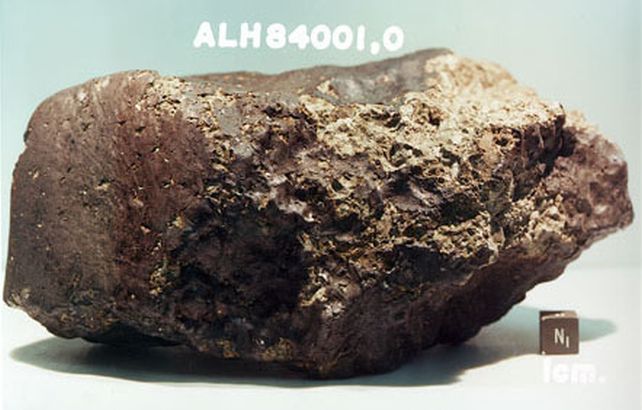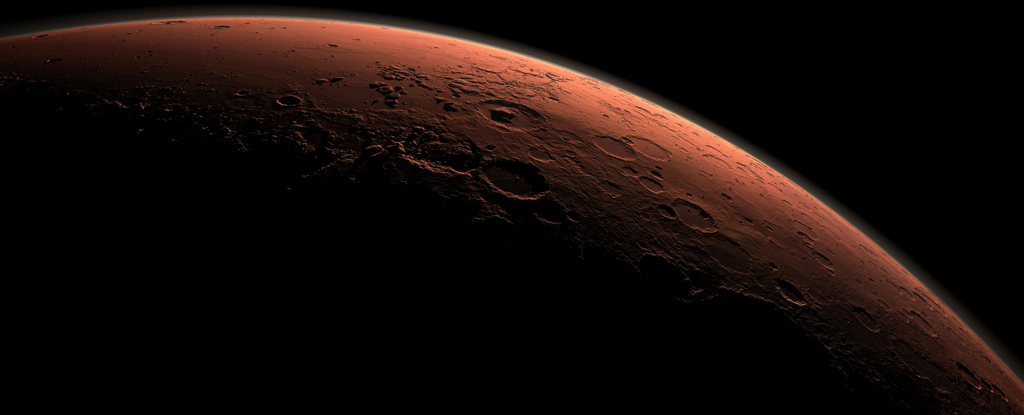A little over a decade ago, a robotic rover on Mars finally found an answer to a burning question. It is now clear that the Red Planet does indeed have organic material buried in the sediment of its ancient lakebeds.
Since then, we’ve found more and more organic molecules on Mars that are distributed in a way that suggests carbon chemistry is prevalent throughout our rusty little neighbor.
This doesn’t mean we’ve found signs of alien life. Far from it; there are many non-biological processes that can produce organic molecules. But where exactly the material came from was a mystery.
Now a research team led by planetary scientist Yuichiro Ueno of the Tokyo Institute of Technology has found evidence that it is created in the atmosphere, where carbon dioxide reacts with ultraviolet sunlight to form a haze of carbon molecules that descends onto the planet’s surface.
While not as exciting as the biology on Mars, the discovery could help us figure out how the ingredients for life arrived on our home planet Earth billions of years ago.
“Such complex molecules based on carbon are a prerequisite for life, the building blocks of life, you might say,” says chemist Matthew Johnson of the University of Copenhagen.
“This is a bit like the old debate about what came first, the chicken or the egg. We show that the organic material found on Mars was formed by atmospheric photochemical reactions – without life. This is the ‘egg’, a prerequisite for life. It remains to be shown whether this organic material has led to life on the Red Planet.”
The idea that photolysis – the process by which molecules are broken down by light – plays a role in the organic chemistry on the Martian surface has been around for a while. Johnson and two colleagues published a paper on the hypothesis in 2013, based on simulations, and others have since explored it further.
What we need, however, is hard evidence from Mars that matches the simulation results.
The photolysis of CO2 produces carbon monoxide and oxygen atoms. But there are two isotopes, or masses, of stable carbon. By far the most common is carbon-12, which has six protons and six neutrons. The next heaviest is carbon-13, which has six protons and seven neutrons.
Photolysis works faster on the lighter isotope. So when UV light photolytically splits the mix of C-12 and C-13 carbon dioxide in the atmosphere, molecules containing C-12 are depleted more quickly, leaving a noticeable ‘excess’ of C-13 carbon dioxide.
This atmospheric carbon-13 enrichment had already been identified a few years ago. The researchers analyzed a meteorite that came from Mars and landed in Antarctica, containing carbonate minerals that had formed from the CO2 in the Martian atmosphere.

“The compelling evidence is that the ratio of carbon isotopes exactly matches our predictions in the quantum chemical simulations, but there was a missing piece in the puzzle,” Johnson explains.
“We were missing the other product of this chemical process to confirm the theory, and that is what we have now obtained.”
That missing piece of the puzzle was found in data obtained by the Curiosity rover in Gale Crater. In the samples of carbonate minerals found on the Martian soil, there is a carbon-13 depletion that matches perfectly the carbon-13 enrichment found in the Martian meteorite.
“There is no other way to explain both the decrease in carbon-13 in the organic material and the enrichment in the Martian meteorite, both in relation to the composition of volcanic CO2 “The amount of gas emitted on Mars has a constant composition, similar to that of volcanoes on Earth, and serves as a baseline,” Johnson said.
This is strong evidence that the carbonaceous organic material Curiosity found formed from carbon monoxide produced by photolysis, the researchers say. And it gives us a clue about the origins of organic material on Earth.
Billions of years ago, when the solar system was still in its infancy, Earth, Venus and Mars all had similar atmospheres, suggesting that the same process was probably happening on our home planet.
The three planets have evolved along very different paths since then, and Mars and Venus seem in their own idiosyncratic ways rather inhospitable to life as we know it. But the rusty desert environment of Mars has now given us a clue to our own origins.
“We haven’t found this ‘smoking gun’ material here on Earth to prove that the process has happened. Maybe because the Earth’s surface is much more alive, geologically and literally, and therefore constantly changing,” Johnson says.
“But it’s a big step that we’ve now found it on Mars, while the two planets were still very similar at that time.”
The team’s findings are published in Nature Geosciences.
